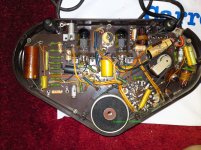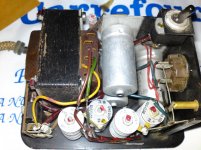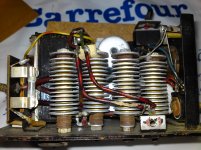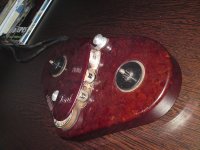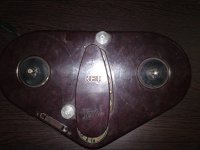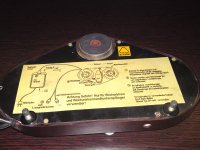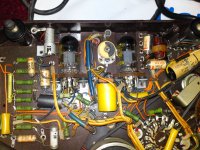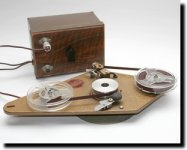Hello all,
I bought a tape to tape reel recorder adapter made by RFT (German Democratic Republic) in 1956. It must be placed on a 78 rpm turntable with the backside- see picture 21. Everything seems to be Ok, even the filter capacitors, but I don't have a turntable anymore. How can i replace the turntable and the drive? I mean in a simple way, of course. Many thanks.
I bought a tape to tape reel recorder adapter made by RFT (German Democratic Republic) in 1956. It must be placed on a 78 rpm turntable with the backside- see picture 21. Everything seems to be Ok, even the filter capacitors, but I don't have a turntable anymore. How can i replace the turntable and the drive? I mean in a simple way, of course. Many thanks.
Attachments
What a novel idea! So the turntable served as the motor for the tape unit? Can we see a photo of the other side where the tape goes?
Seems to me the easiest way is to get a turntable with 78 RPM. Other wise you'll have to build a motor drive at the right speed.
Seems to me the easiest way is to get a turntable with 78 RPM. Other wise you'll have to build a motor drive at the right speed.
I could not find a 78 rpm turntable good enough to work. Only 45 + 33.
the back side....and tubes, 2x ECC81, working.
the back side....and tubes, 2x ECC81, working.
Attachments
Last edited:
Merci pour les photos!
Too bad you can't find the turntable. Many old turntables here in the USA have 78 RPM.
This little unit is so cool it would be wonderful to get it working. Maybe someone here can help with parts or ideas for a custom base and motor.
Too bad you can't find the turntable. Many old turntables here in the USA have 78 RPM.
This little unit is so cool it would be wonderful to get it working. Maybe someone here can help with parts or ideas for a custom base and motor.
I think, 'm not sure, that with a 78rpm the tape recorder speed was 19cm/s. I don't know the frequency range at that speed but I'm asking myself if the 45rpm wolud not give a 9.5cm/s speed for the recorder.
No, the ratio isn't quite right.
Looking on eBay in the USA there are quite a few 78 RPM turntables for good prices. They would not work in France because the the 50/60Hz difference. They would run slow.
Looking on eBay in the USA there are quite a few 78 RPM turntables for good prices. They would not work in France because the the 50/60Hz difference. They would run slow.
There was a later machine called a Gramdeck based on the same principal of the 78 rpm turntable. It was transistorised, if I remember rightly and may not have been sold much outside the U.K.
The strength of this principal is the fact that most 78 rpm turntables have negligible wow and flutter, due to the flywheel effect of the large turntable. If you drive it any other way you will still need a large flywheel to make W & F acceptable.
It will work at 45 rpm but you will have non standard speed recordings that will only playback on the same unit. Frequency response will also suffer and it may not have been that good in the fist place on a 1956 machine.
The strength of this principal is the fact that most 78 rpm turntables have negligible wow and flutter, due to the flywheel effect of the large turntable. If you drive it any other way you will still need a large flywheel to make W & F acceptable.
It will work at 45 rpm but you will have non standard speed recordings that will only playback on the same unit. Frequency response will also suffer and it may not have been that good in the fist place on a 1956 machine.
Turntables mostly just use synchronous motors. If you can find one from an old turntable and build a pulley and flywheel arrangement, you would be good. Of course the final RPM being 78.
I`m sure an electronic servo could be made to work but I think it would be quite a lot of work to get a decent performance at 78 rpm. It would probably be relatively easy to get a reasonable wow performance but the short term (flutter) would be very tricky, since the machine would not present a constant torque requirement due to pinch roller ecentricity and variations in the take up clutch, amongst other things. This is why a large flywheel (turntable) is such a good solution. A very good and probably expensive motor would be required.
It must be possible to find an old record player from the 50`s or 60`s in someones loft?
It must be possible to find an old record player from the 50`s or 60`s in someones loft?
This is what I must do, i think. We have a day in the year when people leave away (not sure about the word: abandon) old electronics in order to be collected by municipalities. I will look for an old one. Found something on the ebay, but the item is cheaper than the shipping.
But, please, the "direct drive" motor has a 78rpm speed itself ?
(used in "direct drive" turntables)
But, please, the "direct drive" motor has a 78rpm speed itself ?
(used in "direct drive" turntables)
A direct drive motor will certainly drive a turntable at 78 rpm but the flywheel effect of the turntable is part of the design. If you remove the platter from a direct drive turntable you will probably see the motor running erratically due to a lack of the flywheel effect of the large diameter platter.
In fact most older turntables used Asynchronous motors as Synchronous types are generally larger for a given running torque and also have relativly low torque at startup. But a motor driving a decent sized flywheel at 78 rpm is almost a turntable less the rubber mat!
In fact most older turntables used Asynchronous motors as Synchronous types are generally larger for a given running torque and also have relativly low torque at startup. But a motor driving a decent sized flywheel at 78 rpm is almost a turntable less the rubber mat!
New "plattenspieler" found:
ION Plattenspieler mit USB Anschluß 45/78RPM ~NEU~ en vente sur eBay.fr (fin le 28-oct.-10 15:06:42 Paris)
do you think it can be powerful enough to move the thing ?
ION Plattenspieler mit USB Anschluß 45/78RPM ~NEU~ en vente sur eBay.fr (fin le 28-oct.-10 15:06:42 Paris)
do you think it can be powerful enough to move the thing ?
Impossible to say without trying it out but probably not - older turntables had a fair ammount of power in reserve to overcome voltage variations, heavy pickups and so on, modern designs don`t need so much power , the electronis sorts it out.
Moving tape, running the takeup and the load of the pinch roller add up to more than thr drag of a pickup head.
Moving tape, running the takeup and the load of the pinch roller add up to more than thr drag of a pickup head.
- Status
- Not open for further replies.
- Home
- Source & Line
- Analogue Source
- RFT tape recorder
